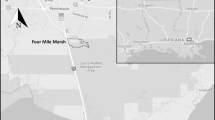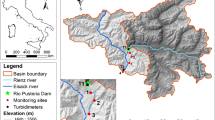Abstract
The purpose of this study was to determine which of the following artificial stream designs would be most logistically simple yet effective in maintaining riffle insects during a 30 d bioassay: 1) static and no current (S-NC); 2) flow-through and no current (FT-NC); 3) static with current (S-C); or 4) flow-through with current (FT-C). Flow-through and current, when provided, were 12 ml min−1 and 30 cm sec−1, respectively. Streams were covered by emergence traps, and daylight equivalent lights provided a natural photoperiod. The four stream designs were evaluated in triplicate based on changes in insect species-abundances after 30 d. Test organisms were transferred to the artificial streams in rock-filled containers previously colonized for 30 d in a third-order mountain stream riffle. Additional colonized substrates were sampled immediately to provide an estimate of initial densities placed in the artificial streams. Hess samples were taken directly from the source riffle to evaluate how well the artificial substrates reflected species-abundances on the natural substrate. Adults were collected from the artificial streams every 48–72 h to determine the percentage of initial densities that emerged. After 30 d (7 Aug–6 Sept, 1986), all organisms remaining in the streams were censused. Designs were evaluated using combined densities of adults and young.
Relative to benthic samples taken directly from the source riffle, the artificial substrates selected for collector-filterers and against collector-gatherers. The FT-C and S-C stream designs maintained most taxa at or above initial densities, and even in the FT-NC and S-NC streams densities of some taxa were not significantly different (P ≤ 0.05) from initial densities. Emergent adults comprised a large proportion of mayfly and chironomid densities and must be monitored during bioassays with aquatic insects. These results indicate that microcosms of riffle insect communities can be maintained for at least 30 d with moderate current and minimal flow-through.
Similar content being viewed by others
References
Allard, M. & G. Moreau, 1987. Effects of experimental acidification on a lotic macroinvertebrate community. Hydrobiologia 144: 37–49.
Barton, D. R. & R. R. Wallace, 1979. The effects of an experimental spillage of oil sands tailings on benthic invertebrates. Envir. Pollut. 18: 305–312.
Benfield, E. F., A. C. Hendricks & J. Cairns, Jr., 1974. Proficiencies of two artificial substrates in collecting stream macroinvertebrates. Hydrobiologia 45: 431–440.
Burks, S. L. & J. L. Wilhm, 1977. Bioassays with a natural assemblage of benthic macroinvertebrates. In F. L. Mayer & J. L. Hamelink (eds.), Aquatic Toxicology and Hazard Evaluation, STP 634. American Society for Testing and Materials, Philadelphia, Pennsylvania: 127–136.
Cairns, J., Jr. (ed.), 1985. Multispecies Toxicity Testing. Pergamon Press, London, 261 pp.
Cairns, J., Jr. (ed.), 1986. Community Toxicity Testing, STP 920. American Society for Testing and Materials, Philadelphia, Pennsylvania, 350 pp.
Cairns, J., Jr. & M. S. Henebry, 1982. Interactive and noninteractive protozoan colonization processes. In J. Cairns, Jr. (ed.), Artificial Substrates. Ann Arbor Science Publishers, Inc., Ann Arbor, Michigan: 23–70.
Cairns, J., Jr., J. S. Crossman, K. L. Dickson & E. E. Herricks, 1971. The recovery of damaged streams. Assoc. Southeastern Biol. Bull. 18: 79–106.
Clubb, R. W., A. R. Gaufin & J. L. Lord, 1975. Acute cadmium toxicity tests upon nine species of aquatic insects. Envir. Res. 9: 332–341.
Culp, J. M., S. J. Walde & R. W. Davies, 1983. Relative importance of substrate particle size and detritus to stream benthic macroinvertebrate distribution. Can. J. Fish. Aquat. Sci. 40: 1568–1574.
Edmunds, G. F., S. L. Jensen & L. Berner, 1976. The mayflies of North and Central America. University of Minnesota Press, Minneapolis, 330 pp.
Fenneman, N. M., 1938. Physiography of the eastern United States. McGraw-Hill, NY, 714 pp.
Gauss, J. D., P. E. Woods, R. W. Winner & J. H. Skillings, 1985. Acute toxicity of copper to three life stages of chironomus tentans as affected by water hardness-alkalinity. Envir. Pollut. 37: 149–157.
Giesy, J. P., Jr., 1980. Microcosms in Ecological Research. National Technical Information Center, Springfield, Virginia, 1110 pp.
Godbout, L. & H. B. N. Hynes, 1982. The three dimensional distribution of the fauna in a single riffle in a stream in Ontario. Hydrobiologia 97: 87–96.
Green, D. W. J., K. A. Williams & D. Pascoe, 1986. Studies on the acute toxicity of pollutants to freshwater macroinvertebrates 4. Lindane (γ-Hexachlorocyclohexane). Arch. Hydrobiol. 106: 263–273.
Jensen, L. D. & A. R. Gaufin, 1964. Effects on ten organic insecticides on two species of stonefly naiads. Trans. am. Fish. Soc. 93: 27–34.
Maki, A. W., L. Geissel & H. E. Johnson, 1975. Comparative toxicity of the larval lampricide TFM (3 triflouromethyl-4-nitrophenol) to selected benthic macroinvertebrates. J. Fish. Res. Bd Can. 32: 1455–1459.
Merritt, R. W. & K. W. Cummins, 1984. An Introduction to the Aquatic Insects of North America, 2nd ed., Kendall/Hunt, Dubuque, Iowa, 722 pp.
Millemann, R. E., W. J. Birge, J. A. Black, R. M. Cushman, K. L. Daniels, P. J. Franco, J. M. Giddings, J. F. McCarthy & A. J. Stewart, 1984. Comparative acute toxicity to aquatic organisms of components of coal-derived synthetic fuels. Trans. am. Fish. Soc. 113: 74–85.
Odum, E. P., 1984. The mesocosm. Bioscience 34: 558–562.
Pontasch, K. W. & M. A. Brusven, in press. Macroinvertebrate response to a gasoline spill in Wolf Lodge Creek, Idaho, USA. Archiv. Hydrobiol.
Rehwoldt, R., L. Lasko, C. Shaw & E. Wirhowski, 1973. The acute toxicity of some heavy metal ions toward benthic organisms. Bull. Envir. Contain. Toxicol. 10: 291–294.
Rosenberg, D. M. & V. H. Resh, 1982. The use of artificial substrates in the study of freshwater benthic macroinvertebrates. In J. Cairns, Jr. (ed.), Artificial Substrates. Ann Arbor Science Publishers, Inc., Ann Arbor, Michigan: 175–236.
Sanders, H. O. & O. B. Cope, 1968. The relative toxicities of several pesticides to naiads of three species of stonefly. Linmol. Oceanogr. 33: 112–117.
Shaw, D. W. & G. W. Minshall, 1980. Colonization of an introduced substrate by stream macroinvertebrates. Oikos 34: 259–271.
Slooff, W., 1983. Benthic macroinvertebrates and water quality assessment: some toxicological considerations. Aquat. Toxicol. 4: 73–82.
Spehar, R. L., R. L. Anderson & J. T. Fiandt, 1978. Toxicity and bioaccumulation of cadmium and lead in aquatic invertebrates. Envir. Pollut. 15: 195–208.
Stout, R. J. & W. E. Cooper, 1983. Effect of p-cresol on leaf decomposition and invertebrate colonization in experimental outdoor streams. Can J. Fish. Aquat. Sci. 40: 1647–1657.
Williams, D. D. & H. B. N. Hynes, 1974. The occurrence of benthos deep in the substratum of a stream. Freshwat. Biol. 4: 233–256.
Williams, K. A., D. W. J. Green & D. Pascoe, 1986a. Studies on the acute toxicity of pollutants to freshwater macroinvertebrates, 3. Ammonia. Arch. Hydrobiol. 106: 61–70.
Williams, K. A., D. W. J. Green, D. Pascoe & D. E. Gower, 1986b. The acute toxicity of cadmium to different larval stages of Chironomus riparius (Diptera: Chironomidae) and its ecological significance for pollution regulation. Oecologia 70: 362–366.
Author information
Authors and Affiliations
Rights and permissions
About this article
Cite this article
Pontasch, K.W., Cairns, J. Establishing and maintaining laboratory-based microcosms of riffle insect communities: their potential for multispecies toxicity tests. Hydrobiologia 175, 49–60 (1989). https://doi.org/10.1007/BF00008474
Received:
Revised:
Accepted:
Issue Date:
DOI: https://doi.org/10.1007/BF00008474




